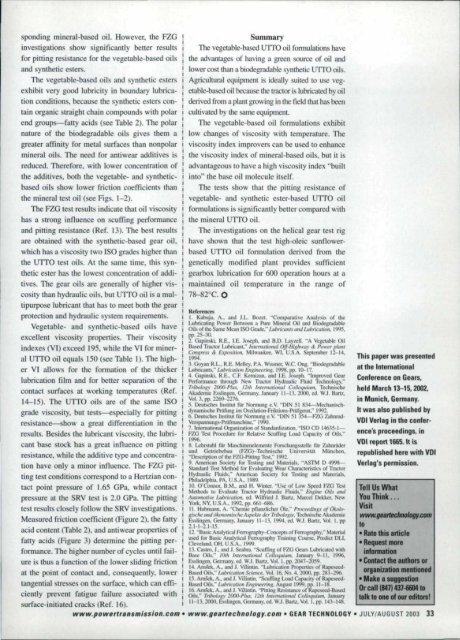Download the July/August 2003 Issue in PDF format - Gear ...
Download the July/August 2003 Issue in PDF format - Gear ...
Download the July/August 2003 Issue in PDF format - Gear ...
You also want an ePaper? Increase the reach of your titles
YUMPU automatically turns print PDFs into web optimized ePapers that Google loves.
spend<strong>in</strong>g m<strong>in</strong>eral-based oil, However. <strong>the</strong> FZG<br />
<strong>in</strong>vestigations show significantly better results<br />
for pitt<strong>in</strong>g re i lance for <strong>the</strong> vegetable-ba ed oils<br />
and synLl1eti.c e ters.<br />
The vegetable-based oils and syn<strong>the</strong>tic esters<br />
exhibit very good lubricity <strong>in</strong> boundarylubrication<br />
conditions. because <strong>the</strong> syn<strong>the</strong>tic esters con-<br />
La<strong>in</strong> organic straight cha<strong>in</strong> compounds with polar<br />
end groups=fauy acid (see Table 2). The polar<br />
nature of <strong>the</strong> biodegradable oils gives <strong>the</strong>m a<br />
greater aff<strong>in</strong>ity for metal surfaces than nonpolar<br />
m<strong>in</strong>eral oil . The need for anti wear additives is<br />
reduced. Therefore, with lower concentration of<br />
<strong>the</strong> additive , both <strong>the</strong> vegetable- arid syn<strong>the</strong>ticba<br />
ed oil how lower fri.cLion coefficients than<br />
<strong>the</strong> m<strong>in</strong>eral test oil (see Figs. 1-2).<br />
The FZG Lest results <strong>in</strong>dicate that oil viscosity<br />
has 3. strong <strong>in</strong>fluence on cuff<strong>in</strong>g performance<br />
and pitt<strong>in</strong>g resistance (Ref. 13). The best results<br />
are obta<strong>in</strong>ed with <strong>the</strong> yn<strong>the</strong>tic-ba ed gear oil,<br />
which has a vi cosity two ISO grades higher than<br />
<strong>the</strong> UTTO te t oils. At <strong>the</strong> arne time. this syn<strong>the</strong>tic<br />
ester has <strong>the</strong> lowe t concentration of additive<br />
. The gear oils are generally of higher vi -<br />
cosity than hydraulic oils. but UITO oil is a multipurpose<br />
lubricant that has 10 meet both<strong>the</strong> gear<br />
protection and hydraulic system requirements.<br />
Vegetable- and syn<strong>the</strong>tic-based oil have<br />
excellent viscosity propertie . Their viscosity<br />
<strong>in</strong>dexes (VI) exceed 1.95. while <strong>the</strong> V] for m<strong>in</strong>eraI<br />
UITO cil equals ISO (see Table I),. The higher<br />
VI allow- for <strong>the</strong> <strong>format</strong>ion of <strong>the</strong> thicker<br />
lubrication film and for better separation of <strong>the</strong><br />
contact surfaces at work<strong>in</strong>g temperatures (Ref.<br />
~4-15). The UTIO oils are of <strong>the</strong> arne ISO<br />
grade vis co ity, but tests=-e pecially for pitt<strong>in</strong>g<br />
resistance-show a great. differentiation <strong>in</strong> <strong>the</strong><br />
results. Besides <strong>the</strong> lubricant viscosity. <strong>the</strong> lubricant<br />
base stock: has a great <strong>in</strong>fluence on pitt<strong>in</strong>g<br />
resistance, while <strong>the</strong> additive type and concentration<br />
have onty a m<strong>in</strong>or <strong>in</strong>fluence. The fZjG pitt<strong>in</strong>g<br />
test conditions corre pond to a Henzian contact<br />
po<strong>in</strong>t pre sure of 1.65 GPa. while contact<br />
pres 1IIfe at <strong>the</strong> SRV te ti 2.0 GPa. The pitt<strong>in</strong>g<br />
test results elo ely follow <strong>the</strong> SRV <strong>in</strong>ve tigations.<br />
Measured friction coefficient (Figure 2), <strong>the</strong> fatty<br />
acid content {Table 2). and antiwear propertie of<br />
fatty acids (Figure 3) determ<strong>in</strong>e <strong>the</strong> p<strong>in</strong><strong>in</strong>g performance<br />
..The higher number ofcycles until failure<br />
is thus a function of<strong>the</strong> lower slid<strong>in</strong>g friction<br />
at <strong>the</strong> po<strong>in</strong>t. of contact and. consequeruly, [ower<br />
tangential stresses on <strong>the</strong> surface. which can efficiently<br />
prevent fatigue failure associated w.ith<br />
Summary<br />
The vegetable-based lJITO oil formulations have<br />
<strong>the</strong> advantages of hav<strong>in</strong>g a green ouree of oil and<br />
lower cost than a biodegradable<br />
yn<strong>the</strong>tic UTfO oils.<br />
Agricultural equipment. is ideally uited to lise vegetable-based<br />
oil because <strong>the</strong> tractor is lubricated by oiI<br />
derived from a plant grow<strong>in</strong>g <strong>in</strong> '<strong>the</strong> field that has been<br />
cultivated by tile<br />
arne equipment.<br />
The vegetable-based oil formulations exhibit<br />
[ow changes of viscosity with temperature, The<br />
vi co it)' <strong>in</strong>dex improvers<br />
<strong>the</strong> viscosity<br />
can be used to enhance<br />
<strong>in</strong>dex of m<strong>in</strong>eral-based oil • but it is<br />
advantageous to have a high viscosity <strong>in</strong>dex "buill.<br />
<strong>in</strong>to" <strong>the</strong> base oil molecule<br />
itself.<br />
The te ts how that <strong>the</strong> pitt<strong>in</strong>g resistance of<br />
vegetable- and syn<strong>the</strong>tic ester-based UTIO oil<br />
formulations is significantly better compared with<br />
<strong>the</strong> m<strong>in</strong>eral UITO oil.<br />
The <strong>in</strong>vestigations on <strong>the</strong> helical gear te t rig<br />
have shown that <strong>the</strong> test high-oleic uaflowerbased<br />
UITO oil formulation derived from <strong>the</strong><br />
genetically modified plant. provides ufflcient<br />
gearbox lubricationfor 600 operation hours at. a<br />
ma<strong>in</strong>ta<strong>in</strong>ed oil temperature <strong>in</strong> <strong>the</strong> range of<br />
78-82°C·O<br />
R Ierences<br />
I, Kabuja, 1\.. and J.I... Bozet, "Comparative Analysis of <strong>the</strong><br />
Lubricat<strong>in</strong>g<br />
Oils oflhe<br />
Power Between (l Pure<br />
Same Mean tSOGrnde."<br />
MUlCraI Oil and Biodegmdable<br />
whrirum, and uwrirnrwll. 1995.<br />
pp.25-3O.<br />
2. Gap<strong>in</strong> ki, RE,. LE. Joseph, and B,D, Layzell. "A Vegetable Oil<br />
Bused Tractor Lubricant." lntemational Off-Highway

















